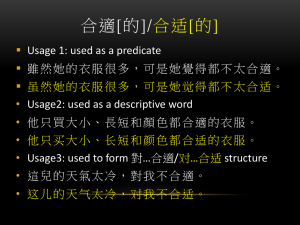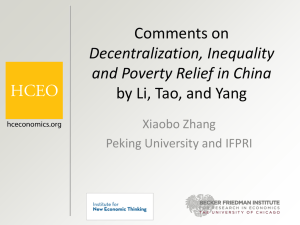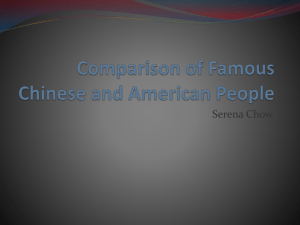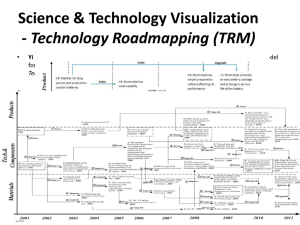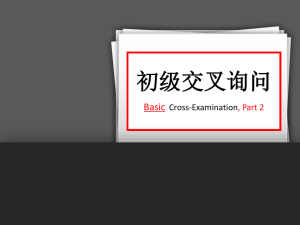“ Event by Event Fluctuation in Heavy
advertisement
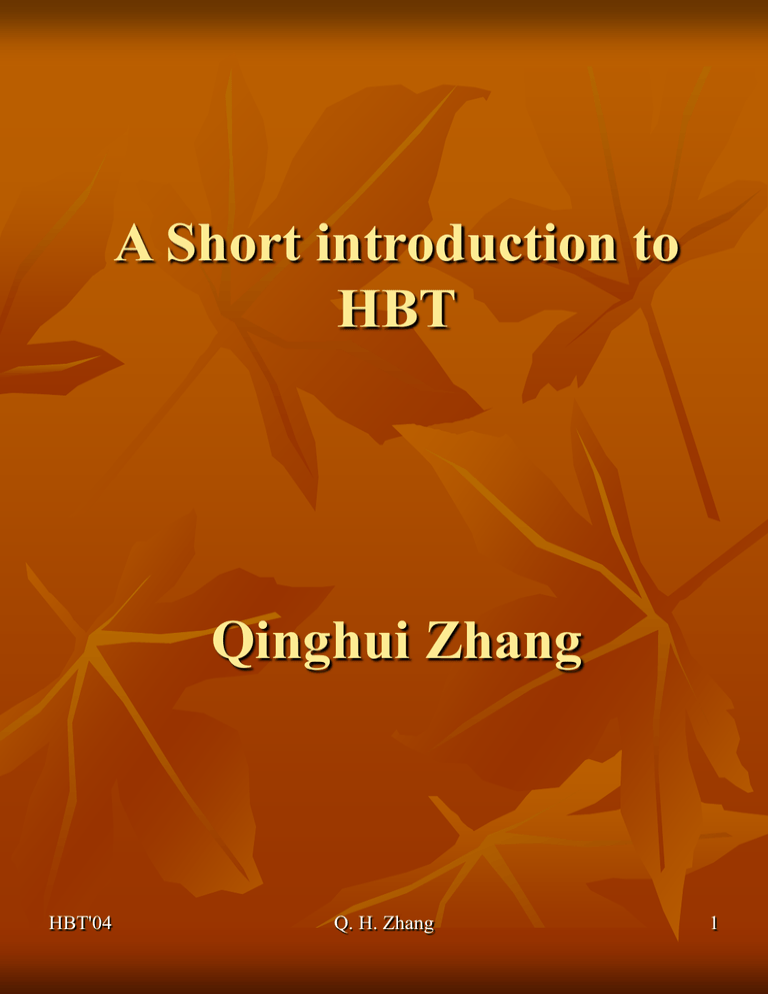
A Short introduction to
HBT
Qinghui Zhang
HBT'04
Q. H. Zhang
1
Heavy Ion Collisions requires
understanding particle distributions
in coordinate and
momentum space
HBT'04
Q. H. Zhang
2
GGLP
HBT
Goldhaber, Goldhaber, Lee and Pais
(1960)
First application of “intensity
interferometry” in particle physics
Hanbury-Brown and Twiss (1950’s)
Revolutionary development of
intensity interferometry in
astronomy
B-E
HBT'04
Bose-Einstein (1920’s)
Role of Bose statistics in
fluctuations
Q. H. Zhang
3
HBT'04
Q. H. Zhang
4
1
X
Source
y
2
Neglects
Momentum dependence of source
Quantum mechanics up to x and y
Final State Interactions after x and y
C2(q) contains shape information
HBT'04
Q. H. Zhang
5
That is, squared Fourier Transforms
measure (only) relative separations of
Sphere vs
source coordinates
hemisphere
Very different sources r(x)
can give very similar
distributions in
relative separation
qOUT R
HBT'04
Q. H. Zhang
6
C 2 (q ) 1 | r (q ) | 2 , r (q ) r ( x )e iqx d 4 x
q p1 p 2 ( E 1 E 2 , p1 p 2 ) (q 0 , q )
q x (q 0 t q r )
Fourier Transform provides one time
and three space extensions of source
BUT:
2 2
2
2
E1 E 2
p1 p 2
q0 E1 E 2
E1 E 2
E1 E 2
p1 p 2
( p1 p 2 )
q V PAIR
E1 E 2
That is, q0 is not an independent
quantity in the F.T.
(e.g., note that q 0 | q | )
Fourier Transform has support in only
half of the q0-q plane
HBT'04
Q. H. Zhang
7
C 2 (q ) 1 | r (q ) | 2 , r (q ) r ( x )e iqx d 4 x
q 0 q V PAIR
q x (q V PAIR t q r ) q ( r V PAIR t )
iq ( r V PAIRt )
r (q ) r (q ;V PAIR ) r ( x )e
d4x
So Fourier transform (+ two-particle
kinematics) already provides conclusion:
C 2 (q ) 1 | r (q ) | C 2 (q ; V PAIR ) ( r V PAIR t ) 2
2
Additional dynamic effects (expansion,
thermal source, …) will also lead to
systematic dependence of extracted
“radii” on VPAIR (or mT or kT or …)
HBT'04
Q. H. Zhang
8
So
ur
c
e
q
Y-Axis
P1
K
P2
qSIDE
Beam
Axis
ZAx
is
X-Axis
qLONG
Source
qOUT
There are other decompositions...
HBT'04
Q. H. Zhang
9
1 1 x 2x 2 y 2y 2 z 2z 2 t 2t 2
r (rr(,rt ,)t~) ~exp[
exp[
( ( 2 2 2 2 2 2 2 )]2 )]
2 2RR
RR
RzRz
x x
y y
1 1 2 2 2 2 2 2 2 2 2 2 2 2 2 22 2
r (rq(q; V; V
)
)
exp[
exp[
(q(xq xRR
q yq yRR
q zq zRzRz
(q(q V V
) ) )] )]
PAIR
PAIR
x x
y y
PAIR
PAIR
22
Simplest possible (yet still very useful)
case:
e
ur
c
So
q
Choose frame so that
x = “Out” (that is, parallel to VPAIR)
y = “Side”
z = “Long”:
Y-Axis
P1
K
P2
qSIDE
Beam
Axis
ZAx
is
X-Axis
z
qLONG
y
x
Source
qOUT
2
2
2
2
2
2
(q x R x q y R y q z Rz (q V PAIR ) 2 2 )
q SIDE R SIDE q LONG R LONG qOUT ROUT with ROUT R x V PAIR 2
2
Symmetry
HBT'04
2
2
2
2
2
2
2
2
" " R y R x ROUT R x V PAIR 2 R SIDE R y
2
Q. H. Zhang
2
2
2
10
2
Most experiments with charged
tracking and particle identification
have HBT results:
BNL AGS:
E859, E866
E877
E895
CERN SPS:
NA44
NA49
WA98
RHIC
PHENIX
HBT'04
STAR
Q. H. Zhang
11
The Great Puzzle:
Why so little variation with ECM ?
Why are lifetimes () ~ 0 ??
( especially at RHIC )
HBT'04
Q. H. Zhang
12
systematic errors in experimental data is
required:
Definition of C2
Coulomb corrections
Role of l, dependence of R on same
Contributions from resonances
(especially when comparing between
different experiments)
A better understanding of theoretical
assumptions and uncertainties is
required:
HBT'04
Resonance contributions
Lorentz effects
Modeling of expansion, velocity profiles
Q. H. Zhang
13
Our favorite (charged) bosons never
have pure plane-wave states
HBT'04
Even our ideal-case Fourier transform
becomes a “Coulomb transform”
This particular case is easy to treat
analytically via “Gamow” or “Coulomb”
corrections:
Q. H. Zhang
14
Some indication from both AGS and
SPS that RSide(--) > RSide(++)
E877 (AGS): RSide(--) ~ (1.5 +/0.4)*RSide(++) R (--) > R (--)
TSide
TOut
NA44 (SPS): RTSide(++) < RTOut(++)
Ze
Note external Coulomb
HBT'04
•Systematic in RSIDE
•Cancels in ROUT
-
-
Q. H. Zhang
Ze
15
r (q ) r ( x )e iqx d 4 x r (q 0) 1
C 2 ( q 0) 2
versus observed value of 1.1-1.5
This is parameterized away via
C2(q) = 1+ l | r(q)|2 , l ~0.1-0.5
“Understood” via assumed resonance
contributions:
HBT'04
Q. H. Zhang
16
How do resonances affect l ?
By creating a “halo” around the
source “core”:
Some culprits:
r (G = 150 MeV S ~
1.3 fm )
K* K (G =
50 MeV S ~
4
fm )
w (G =
8.4 MeV S ~
20
fm )
,
h h (G =
0.2 MeV S ~
200
fm )
2(1-fCORE )fCORE (1-fCORE )(1-fCORE )
fCORE fCORE
(and many more…)
Core
2
Effect: C2 develops
structure near
q=0 to describe
the various sources:
1
Momentum
resolution
pHBT'04
p
Halo
Combination
C2(q)
0
Q. H. Zhang
0
(~ 1%) (~ 1%) p [Ge V/c]
50
q (MeV/c)
100
17
Using Wigner function:
See for example:
Chao, Gao and Zhang
Phys. Rev. C 49,3224 (1994)
Use ~this in
cascade codes
HBT'04
Q. H. Zhang
18
Expect C2 to depend on q and K
B.R. Schlei and N. Xu:
HBT'04
Q. H. Zhang
19
RQMD vs. Data for HBT
Final state phase space
points xi are weighted
by
1 HBT'04
+ cos[(pa-pb)(xa-xb)]Q. H. Zhang
20
This approach is
Plausible
WRONG
Final state phase space
points xi are weighted
by
1 + cos[(pa-pb)(xa-xb)]
with
Advantage:
Uses precisely what codes produce
Disadvantage
Can lead to non-physical oscillations in C2
First noted empirically by Weiner et al and
Later matin et al.
Theoretical analysis by Q.H. Zhang et al.
Phys. Lett. B 407, 33 (1997)
Quantitatively, is it significant for heavy ion
HBT'04 collisions?
Q. H. Zhang
21
Answer 1: No (Empirical)
Study these effects with a source that
explicitly parameterizes x-p
correlations:
Examples for R=5fm, P=200 MeV/c
500
Naive
400
300
Correct
Usual (used in MC's)
2
K
0
p (MeV/c)
100
S=0
C2(q)
200
1
-100
-200
x
-300
0
-400
0
100
q (MeV/c)
-500
-10
-8
-6
-4
-2
0
R (fm)
2
4
6
8
200
10
500
Naive
400
Correct
Usual (used in MC's)
300
2
0
p (MeV/c)
100
S=0.33
C2(q)
200
1
-100
-200
0
-300
0
100
q (MeV/c)
-400
200
-500
-6
-4
-2
0
R (fm)
2
4
6
8
10
Naive
500
400
Correct
Usual (used in MC's)
2
300
S=0.9
200
100
0
HBT'04
-100
-200
-300
-400
C2(q)
-8
1
p (MeV/c)
-10
Q. H. Zhang
22
0
0
100
q (MeV/c)
200
Q. Can one remove these pathologies
from ~classical predictions?
A. Yes (Q.H. Zhang et al.):
Smear the phase space points (x,p) with
minimum uncertainty wave-packets:
with s ~ 1 fm
Pictorially:
500
5
400
4
300
3
200
2
100
1
0
p (MeV/c)
=
-100
0
-
-200
-
-300
-
-400
-
-500
-8
-6
-4
-2
0
R (fm)
2
4
6
8
-
10
-10
-8
-6
-4
-2
0
R (fm)
2
4
This can be done analytically with
parameterization
on previous slide:
x
500
400
300
200
100
0
p(MeV/c)
-10
-100
-200
-300
-400
-500
-10
-8
-6
-4
-2
R
HBT'04
0
(fm
2
4
6
8
10
)
Q. H. Zhang
23
6
8
10
What are the Lorentz properties of
C2(q)?
d 6n
3
3
E1 E 2
d 6n
3
3
dp dp
dp1 dp 2
C 2 ( p1 , p 2 ) 3 1 23
Lorentz Invariant
d n d n
d 3n
d 3n
E1
E2
3
3
3
3
dp1 dp1
dp1
dp1
How to write our favorite practice Gaussian
in an explicitly Lorentz invariant way?
Answered in
F.B. Yano and S.E. Koonin, Phys. Lett. B78, 556 (1978).
1 r2
t2
r ( r , t ) ~ exp[ ( 2 2 )]
2 R
1 2 2
r (q ; V PAIR ) exp{ [ | q | R (q V PAIR ) 2 2 ) ]}
2
so
2 2
2
C 2 ( p1 , p 2 ) 1 | r (q ; V PAIR ) | 1 exp{ | q | R (q V PAIR ) 2 2 }
i.e. , not explicitly Lorentz covariant
Fix by introducin g source four - velocity u s (1, v s )
2
q q q0 | q |2 ,
q u s (q 0 q v s ) q 0 (in source rest frame)
Then
CHBT'04
qH.
) 2 Zhang
R (q u) 2 [ R 2 2 ]}
2 ( p1 , p 2 ) 1 exp{( q Q.
2
i.e. , explicitly Lorentz covariant
24
Can Lorentz effects “distort”
information?
Apply Yano-Koonin-Podgoretzsky
p1
result to another toy model:
VPAIR
uS
Beam
axis
p2
Apply this to ~1-d motion in “Out” direction:
Study argument of exponentia l
ARG (q q ) 2 R (q u) 2 [ R 2 2 ] for various cases :
Source at rest v S 0 :
2
ARG | q | 2 [ R 2 V PAIR 2 ]
2
ROUT R 2 V PAIR 2
Pair at rest V PAIR 0 :
*2
*2
ARG | q | 2 s [ R 2 v S 2 ]
2
2
ROUT s [ R 2 v S 2 ]
Numerical example : | V PAIR | 1 , | v S | 0.7
2
*2
*2
ROUT (0.4) 2 [ R 2 2 ]
2
Nota Bene: This last case allows ROUT<RSIDE
HBT'04
25
even for ~ RSIDE Q. H. Zhang
The chief lesson from last 10-15
years of (theoretical) HBT work:
The “radii” are a (potentially)
complicated mixture of
Space-time distribution
Spatial flow gradients
Temperature gradients
This average ( r V PAIR t ) 2 is over
space, time, flow profile, temperatur e, .....
More correct terminology:
“radii” “lengths of homogeneity”
In the presence of source dynamics,
“radii” depend on mean pair
(energy, momentum, transverse mass, …)
HBT'04
Q. H. Zhang
26
But :
ROUT/RSIDE
trend
completely
eliminates
one “hydro”
calculation
HBT'04
Soff, Bass, Dumitru,
Phys. Rev. Lett. 86, 3981 (2001)
Q. H. Zhang
27
Plotted versus KT, there is an amazing
consistency between data from AGS,
SPS, and RHIC, spanning a factor of 100
in CM energy(!):
RHIC
AGS
HBT'04
SPS
Q. H. Zhang
28
There is now an extensive
experimental and theoretical
literature built on 20+ years of
“HBT” studies
We’re now ready to start doing
things right:
Experimentally
Theoretically
HBT'04
Measure resonance contributions
Measure like and unlike particle effects
Understand systematic errors
Cascade codes for RHIC
Right parametrization
Coulomb systematics
Q. H. Zhang
29
Multipion correlations
Each events has large number of
pions, therefore, multi-pion
correlation will affect
Two-pion interferometry
(1): If the pion correlation formula
is right?
(2): If it is not right, which kind of
formula should we use!
HBT'04
Q. H. Zhang
30
Seems right!
Zhang, Phys. Rev. C58, 22 (1998)
Proved that for a class model, the
present pion correlation function
formula is right.
However generally, the formula is
not right!
Zhang, Phys. Rev. C59,1646 (1999).
HBT'04
Q. H. Zhang
31
The formula is :
C(p1,p2)=
A(p1,p2)[1+R(p1,p2)]
A(p1,p2) is a function of p1,p2.
R(p1,p2) can be written as the same
as above.
HBT'04
Q. H. Zhang
32
Three-pions correlations
HBT'04
Q. H. Zhang
33
HBT'04
Q. H. Zhang
34
HBT'04
Q. H. Zhang
35
HBT'04
Q. H. Zhang
36
HBT'04
Q. H. Zhang
37
HBT'04
Q. H. Zhang
38
Some of slides taken from
W. A. Zajc, R. Wilson.
Thank you!
HBT'04
Q. H. Zhang
39
